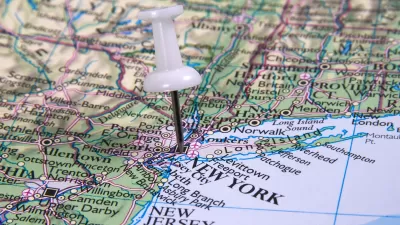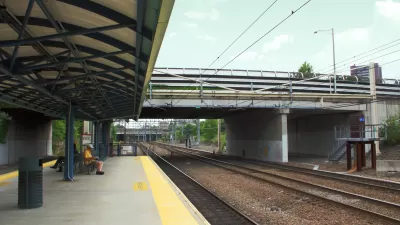The design proposal for the Triboro Corridor is speculative, but meant to inspire the conversation on one of the "4c" ideas at the heart of the Regional Plan Association's Fourth Regional Plan.
Michelle Cohen reports on the results of a design competition announced by the Regional Plan Association in June, "asking for proposals that would transform various areas of the New York metropolitan region."
"One of the four ideas chosen to receive $45,000 was a transportation alternative that would serve the Bronx, Queens, and Brooklyn," according to Cohen. The Triboro Corridor proposal "developed by New York-based firm Only If along with Netherlands-based firm One Architecture, focuses on using a light rail to move passengers between the outer boroughs to alleviate some of the overcrowding that has plagued the current subway system with delays."
Diane Pham also covered the new Triboro idea in an earlier article from June.
The Triboro idea was only one of the design proposals featured in the ongoing 4C exhibit at For Tilden, running through September 17. 4C is a principal component of RPA’s Fourth Regional Plan, "A Region Transformed," according to the 4C website.
4C identifies four regional corridors of particular interest in the New York-New Jersey-Connecticut metropolitan area: Highlands, Coast, City, Suburbs. Together, these corridors represent the full range of policy and design challenges of the region addressed in the fourth plan.
Planetizen most recently picked up news about the grand plans for a Triboro Corridor transit line when the RPA released a policy brief in May 2016.
FULL STORY: New renderings of proposed Triboro Corridor, 17-stop outer borough light rail and linear park

Trump Administration Could Effectively End Housing Voucher Program
Federal officials are eyeing major cuts to the Section 8 program that helps millions of low-income households pay rent.

Planetizen Federal Action Tracker
A weekly monitor of how Trump’s orders and actions are impacting planners and planning in America.

Ken Jennings Launches Transit Web Series
The Jeopardy champ wants you to ride public transit.

Rebuilding Smarter: How LA County Is Guiding Fire-Ravaged Communities Toward Resilience
Los Angeles County is leading a coordinated effort to help fire-impacted communities rebuild with resilience by providing recovery resources, promoting fire-wise design, and aligning reconstruction with broader sustainability and climate goals.

When Borders Blur: Regional Collaboration in Action
As regional challenges outgrow city boundaries, “When Borders Blur” explores how cross-jurisdictional collaboration can drive smarter, more resilient urban planning, sharing real-world lessons from thriving partnerships across North America.

Philadelphia Is Expanding its Network of Roundabouts
Roundabouts are widely shown to decrease traffic speed, reduce congestion, and improve efficiency.
Urban Design for Planners 1: Software Tools
This six-course series explores essential urban design concepts using open source software and equips planners with the tools they need to participate fully in the urban design process.
Planning for Universal Design
Learn the tools for implementing Universal Design in planning regulations.
Ada County Highway District
Clanton & Associates, Inc.
Jessamine County Fiscal Court
Institute for Housing and Urban Development Studies (IHS)
City of Grandview
Harvard GSD Executive Education
Toledo-Lucas County Plan Commissions
Salt Lake City
NYU Wagner Graduate School of Public Service





























